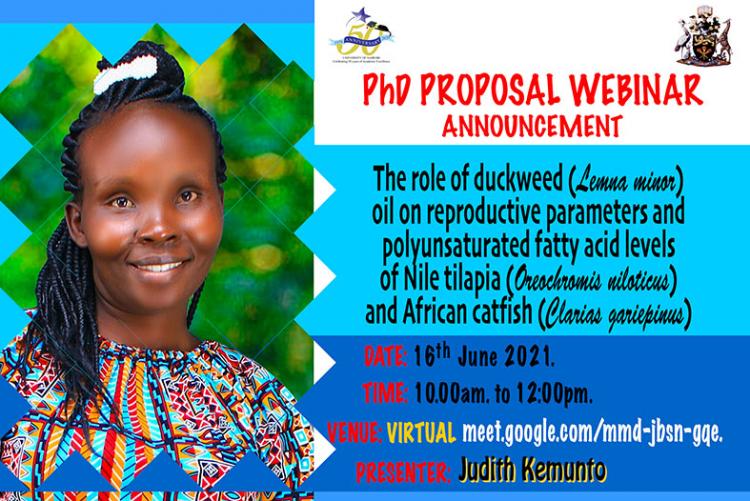
Judith Kemunto (second top left) set to present her Phd proposal on THE ROLE OF DUCKWEED (Lemna minor) OIL ON REPRODUCTIVE PARAMETERS AND POLYUNSATURATED FATTY ACID LEVELS OF NILE
TILAPIA (Oreochromis niloticus) AND AFRICAN CATFISH (Clarias gariepinus).
Fish physiology is affected by nutrition within its environs. Currently, almost all fish feeds
preparation uses animal and fish products as nutrients sources. For instance, Long Chain
Polyunsaturated Fatty Acids (LC PUFA) requirements is sourced through fish oil whose
supply is on the decline. Oils play important roles in reproductive cycle regulation and in the
provision of energy that drives metabolism. However, minimal information exists on how
such oils affects steroidogenesis and oogenesis, which forms a major focus of this study.
Research gaps also exist on how oils used in fish feeds affect major biomarkers of oogenesis
such as choriogenin and vitellogenin as well as fish steroid hormones. Animal based feeds
which provides appropriate nutrient levels have become expensive. There is minimal research
on how plant based macrophytes like Lemna minor feeds affect indigenous fish physiology.
A study will be conducted on the role of Lemna minor oil on reproductive performance and
polyunsaturated fatty acid levels of Nile tilapia (Oreochromis niloticus) and African catfish
(Clarias gariepinus) from July to Dec 2021 and repeated in Jan-July 2022 at Kenya Marine
Fisheries Research Institute Kegati center (KMFRI), Kisii. A 5x3x6 factorial research design
with 5 feeding levels: 0, 25,50,75 and 100% L. minor oil inclusion at three replicates, each
with six fish (4 females and 2 males) in 15 wooden raised box ponds (9m) 3 will be used.
Ninety (90), 2-month old C. gariepinus and 90 O. niloticus, mean weight 50g and 10g
respectively will be used. Waste water will be exchanged at 20% twice daily: morning at
8.00a.m and evening at 7.00 p.m. Physicochemical parameters: dissolved oxygen
concentration, pH, temperature, turbidity, nitrites and ammonia levels will be monitored
using a YSI digital multi parameter probe. Nutritional profile of L. minor will also be
obtained to provide crude protein, fibre, lipid ash and nitrogen free extract levels at the
beginning of the experiment. Fish will be fed twice a day at 10% body weight: at 9.00 a.m.
and at 6.00 p.m. To collect data on: percentage: gonadal somatic index. fertilization, total
number of eggs, hatchability, survivability, motile cells and duration of embryonic stages,
three females spawners from each dietary treatments, will be starved 24 hours, hand-stripped
and 35g of eggs fertilized with milt from sacrificed males of the same dietary treatment. Total
number of fertilized and unfertilized eggs ,milt motility duration, number of motile sperms,
active and dead cells as well as duration of embryonic stages will be observed under an
optical microscope. Gas chromatography and ELISA will be conducted on the body tissues
and serum to obtain LC PUFAs, sex steroids, vitellogenin and choriogenin profiles
respectively.
ANOVA will be used to compare measured PUFAs and reproductive performance
parameters at p < 0.05 followed by Turkey pairwise comparison test. Analyzed data will be
presented using tables, graphs and photomicrographs. Expected results include suitable levels
of L.minor oil for fish feed preparation for optimum reproduction as well as maximum
deposition of omega 3 PUFA in fish. Findings will form a basis for future formulation of
L.minor inclusion in fish feed for use by aquatic farmers as a cheaper alternative source for
omega 3 fatty acids
Keywords: Physiology, macrophytes, Lemna minor, LC PUFAs,growth
performance,reproduction

- Log in to post comments

